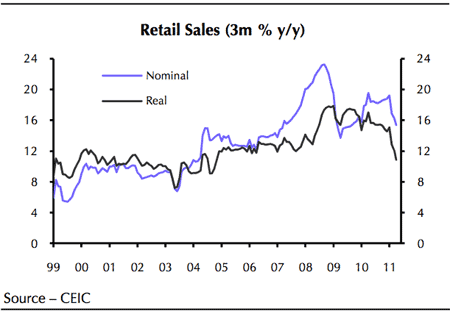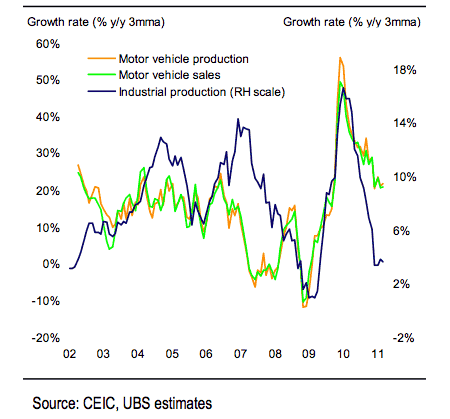Should we worry about a Chinese slowdown?
The markets are not quite sure what to make of China at the moment. Is the economy overheating or slowing down too fast? In truth, both concerns are probably overstated, says Cris Sholto Heaton. Here, he looks at how China and its neighbours are doing, and picks out the the main risks for investors to look out for.

The markets have two main fears when it comes to China. The first is whether the economy is growing too quickly. The second is whether it's slowing too fast.
Obviously it's pretty hard to worry about both at the same time. But sentiment can turn on a sixpence. A few weeks ago, it was received wisdom that China was overheating. Now there's even speculation that policymakers will be cutting rates later this year.
For now, both concerns seem overstated. What's going on in China seems in line with its neighbours. It's unlikely to be a great year for the markets, but it shouldn't be a disaster either. If we want to worry, it probably makes more sense to think years ahead rather than months
MoneyWeek
Subscribe to MoneyWeek today and get your first six magazine issues absolutely FREE

Sign up to Money Morning
Don't miss the latest investment and personal finances news, market analysis, plus money-saving tips with our free twice-daily newsletter
Don't miss the latest investment and personal finances news, market analysis, plus money-saving tips with our free twice-daily newsletter
Asia is already starting to slow
If the question is whether we expect China to grow more slowly in the next few quarters, the answer is yes. And it's not just China most of emerging Asia is due a slowdown in growth.
This is largely self-inflicted. Central banks across the region have been tightening monetary policy in response to higher inflation. As I've discussed previously, that inflation is partly a result of high global commodity prices. But it's also partly a result of capacity constraints within many of these economies, which is to be expected at this stage of the cycle.
If we think back over the last few years, we had overheating in 2007, the world falling apart in 2008, a recovery in 2009 and then full steam ahead in 2010. Now it's time to put on the brakes a bit.
Many central banks are probably behind where they should be understandable since they didn't want to risk tightening too much when their economies were still recovering from the global crisis. So 2011 will be the year when they try to curb inflation before it gets out of hand. That will mean a slowdown starts even while inflation remains high for a few more months.
Hence in China, we're seeing inflation running at 5.3% year-on-year in April. If you want, you can read that as a sign that policy is too loose and the economy is overheating. But if you look at other data, there is evidence the economy is already slowing. For example, retail sales were the weakest in six years (see chart below from Capital Economics).

Similarly in India, the wholesale price index was up by 9% year-on-year in March (wholesale prices are the benchmark for inflation in India because of weakness with the consumer price data). But other indicators are already pointing to a slowdown, as the chart below from UBS shows.

Industrial production growth of just 3.6% year-on-year is probably misleading; some economists argue that the weightings used in constructing the index are outdated and don't reflect the Indian economy today. But other data such as motor vehicle production and sales are also pointing to a more measured slowdown.
This kind of environment is not helpful for stocks. Hence the MSCI China index of Hong Kong listed mainland stocks, the CSI300 - which tracks major shares in Shanghai and Shenzhen, and India's Sensex benchmark are all flat to down since the start of the year. And I'd expect this kind of uneasy market to continue for a while longer.
However, it's important to bear in mind that the reason central banks are tightening is because Asian economies are doing well enough to merit it. The divergence between emerging market (EM) central banks and those of the US, Britain, Europe and Japan tells you a great deal about the different conditions in each set of economies. So while tighter policy is not helpful for stocks in the short term, the outlook is still generally good for the medium term.
China will need to keep a lid on lending
In fact, the bigger risk is that central banks aren't responsible enough to tighten when the need arises. If economies don't slow from time to time, but are allowed to overheat, the eventual fallout will be much worse. And when it comes to China in particular, this seems to me to be a much more worrying prospect for the long term.
Back in 2009, China responded to the global financial crisis with a huge surge in bank lending to boost investment. This was its government stimulus package and the largest and most successful one attempted in any country. The only difference was that it was done through the banks, rather than on the state's balance sheet.
This was a sensible policy, although from an investment point of view it reinforced my distrust of the Chinese banks; they are still expected to put national interest ahead of shareholders and make for an unattractive investment. As I said at the time, it will undoubtedly create some bad loans, but as long as it doesn't continue for too long, it will be worth the cost.
So where are we two years later? Well, policymakers began reining in lending last year and new loans have fallen substantially in recent months (although the latest numbers were significantly higher than expected at RMB740bn).
But as a number of China critics have been pointing out recently, bank loans don't capture all the lending that goes on the economy. There are plenty of other sources of finance, from corporate bonds to unlicensed lenders. And if you look at some wider measures of new financing (see chart below from UBS), you can see that new lending has dropped less than bank loans alone would suggest.

There is some good news in this chart. You can see that the share of new lending taken up by corporate bonds is increasing. This is a positive since China's bond market is underdeveloped and growing it should reduce dependence on the banks, improve access to finance for private sector business and improve transparency and risk management.
However, it's clear that new lending is still some way above where it was before the crisis. And if China doesn't want the risk of a bad debt problem to grow larger than it is at present, it will need to keep policy moderately tight for some time even if the economy is slowing.
I don't expect terribly consistent policymaking in China over the next year or so. There's clearly a lot of jostling for position ahead of the leadership handover next year and this will probably lead to an unwillingness to take tough decisions. So I wouldn't read too much into what happens in the next few months.
But beyond 2012, if we were to see China recklessly focusing on the level of growth instead of trying to improve the quality of growth, I might become more worried. We've been here before in the 1990s, when banks lent recklessly to state-owned enterprises. Malinvestment proliferated, excess capacity ballooned, and ultimately bad debts meant the banking system had to be bailed out.
After several years in which leverage in the Chinese economy actually fell, the lending boom raised the risk of sending the country back down that path. Hopefully the lesson has been learned and history won't repeat itself. But in my view, this not the quarterly GDP numbers is the main risk that investors should be watching.
Get the latest financial news, insights and expert analysis from our award-winning MoneyWeek team, to help you understand what really matters when it comes to your finances.
Cris Sholto Heaton is an investment analyst and writer who has been contributing to MoneyWeek since 2006 and was managing editor of the magazine between 2016 and 2018. He is especially interested in international investing, believing many investors still focus too much on their home markets and that it pays to take advantage of all the opportunities the world offers. He often writes about Asian equities, international income and global asset allocation.
Cris began his career in financial services consultancy at PwC and Lane Clark & Peacock, before an abrupt change of direction into oil, gas and energy at Petroleum Economist and Platts and subsequently into investment research and writing. In addition to his articles for MoneyWeek, he also works with a number of asset managers, consultancies and financial information providers.
He holds the Chartered Financial Analyst designation and the Investment Management Certificate, as well as degrees in finance and mathematics. He has also studied acting, film-making and photography, and strongly suspects that an awareness of what makes a compelling story is just as important for understanding markets as any amount of qualifications.
-
 Zoopla: house price growth stalled in 2025 but forecasts for 1.5% higher next year
Zoopla: house price growth stalled in 2025 but forecasts for 1.5% higher next yearSales soared this year with more than a million deals done but buyers drove hard bargains keeping a lid on prices. A small bounceback in valuations is predicted for 2026, depending on where you live.
-
 UK sets out crypto regulatory proposals
UK sets out crypto regulatory proposalsThe government has tabled legislation that sets out a regulatory framework for cryptocurrencies, while the regulator will consult on balancing innovation and consumer protections
